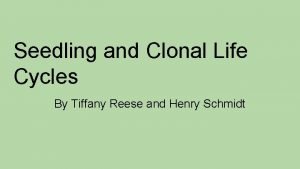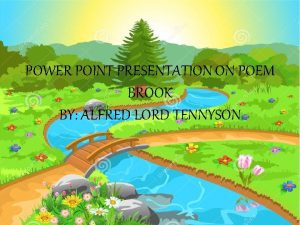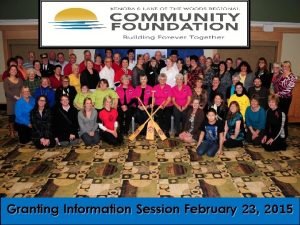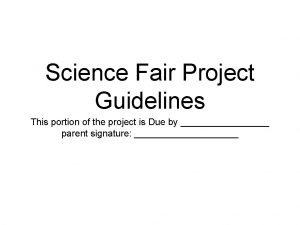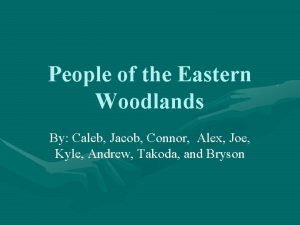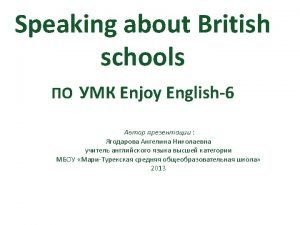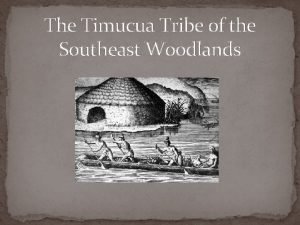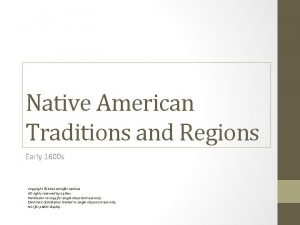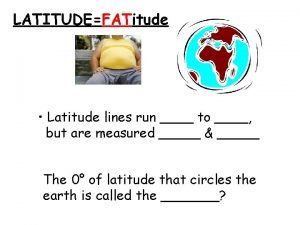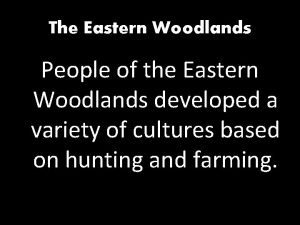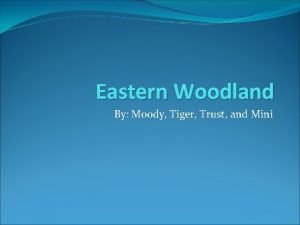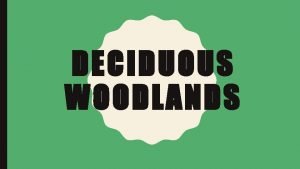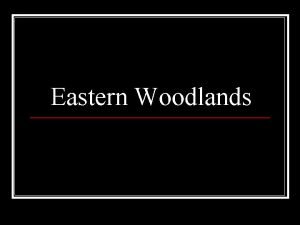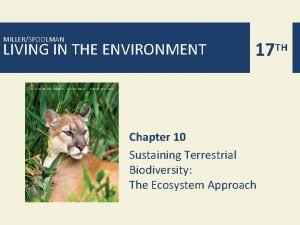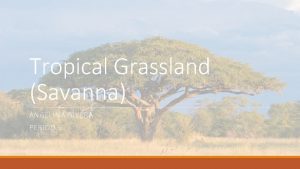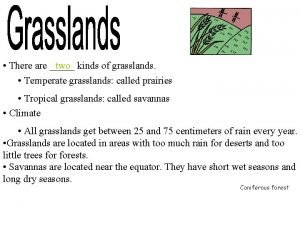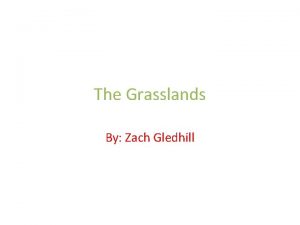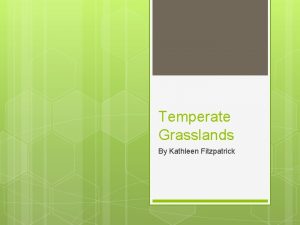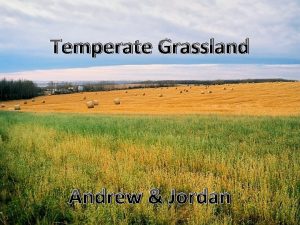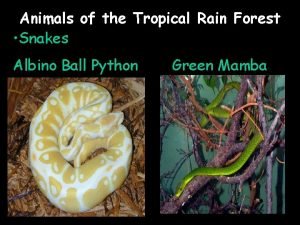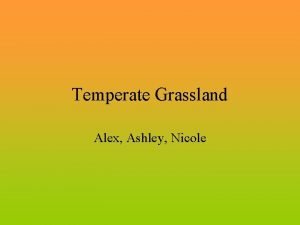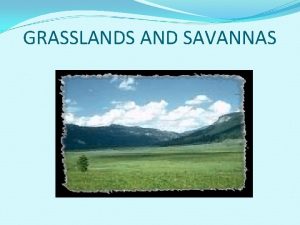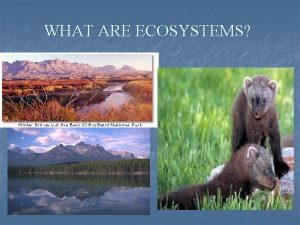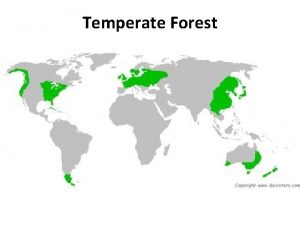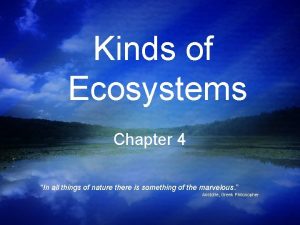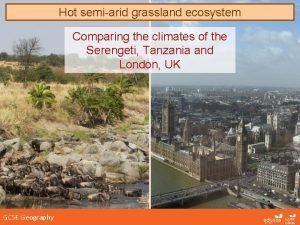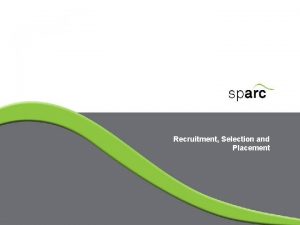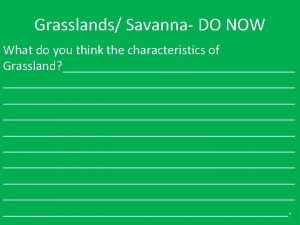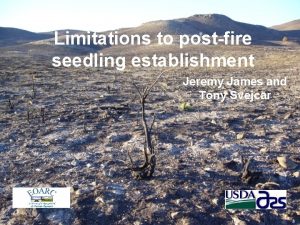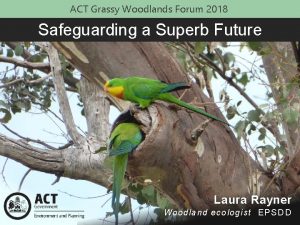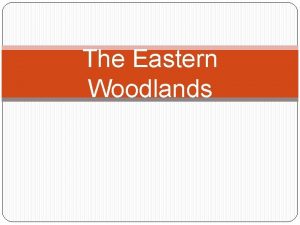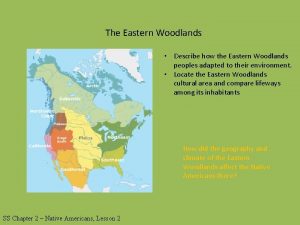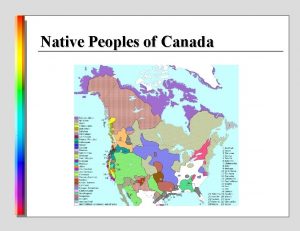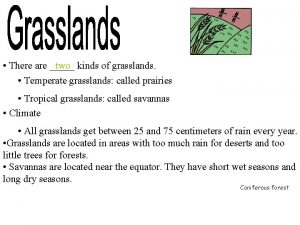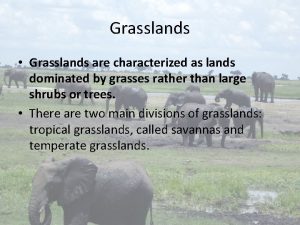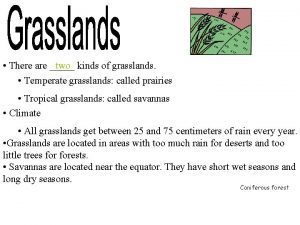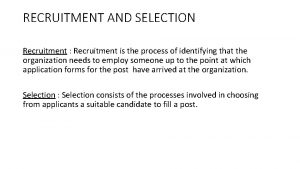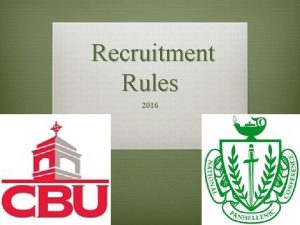Postfire seedling recruitment in grasslands and grassy woodlands











































- Slides: 43

Post-fire seedling recruitment in grasslands and grassy woodlands: insights from field and laboratory trials Joshua Hodges Lydia Guja, Adrienne Nicotra & Jodi Price

Photo: Munro grassland (Credit: Lunt, I. D) Fire-diversity relationships in grassy ecosystems BEFORE AFTER

Indirect effects of fire: the competitive release hypothesis Dense swards prevent light reaching the surface, smothering germinates and limiting growth and flowering Periodic fire reduces competition for light and gaps, allowing smaller species to germinate, establish and flower

Direct effects of fire: fire-cued germination from the seed bank In the absence of fire, seed remains un-germinated in the seed bank and may be lost via aging or predation Fire stimulates germination from the seed bank physically by cracking the seed coat and/or chemically via smoke Seed is dispersed in the seed bank Un-germinated seed

Direct vs Indirect effects in grassy ecosystems Commonly thought that in grassy ecosystems fire does not directly promote recruitment which is linked solely to competitive release and indirect effects Vanilla Lily Arthropodium milleflorum Common Everlasting Chrysocephalum apliculatum Scaly Buttons Leptorhynchos squamatus Billy Buttons Craspedia variabilis

Direct vs Indirect effects in grassy ecosystems Commonly thought that in grassy ecosystems fire does not directly promote recruitment which is linked solely to competitive release and indirect effects Evidenced by: Removal of dense swards increases diversity of forbs and small grasses Vanilla Lily Arthropodium milleflorum Gap-dependence for recruitment in some species (i. e. Rutidosis leptorrhynchoides) Darkness inhabits germination and establishment of forbs and grasses in field and laboratory trials Common Everlasting Chrysocephalum apliculatum Scaly Buttons Leptorhynchos squamatus Billy Buttons Craspedia variabilis

Direct effects on different life stages Studies conducted post-fire mostly focus on re-sprouting individuals or late-stages of recruitment (i. e establishment and flowering), potentially overlooking any direct effects on germination and early growth Vanilla Lily Arthropodium milleflorum

Direct effects on different life stages Studies conducted post-fire mostly focus on re-sprouting individuals or late-stages of recruitment (i. e establishment and flowering), potentially overlooking any direct effects on germination and early growth Germination These. Vanilla concepts are not mutually Lily Arthropodium milleflorum exclusive! Direct and indirect effects influence different life stages Early Growth Direct stimulation Establishment Competitive release Flowering

Management context Important to understand conditions which facilitate successful recruitment of species in threatened ecosystems to ensure long-term viability of populations in situ Grassland restoration site at Euroa, Victoria

Management context Important to understand conditions which facilitate successful recruitment of species in threatened ecosystems to ensure long-term viability of populations in situ Crucial for restoring degraded grasslands and grassy woodlands, as much restoration is done via direct seeding which can be expensive (as much as $60, 000/ha) Grassland restoration site at Euroa, Victoria

Research questions Does fire enhance germination and early growth of grassland grassy woodland plants?

Study region Seed typically dispersed throughout summer and completed by early autumn Past studies and observations in situ suggest these species germinate from autumn-winter Fires typically occur from March- early -June, but can also happen from July. September

Method for broad experiment To understand when germination is likely to occur we are simulating germination a calendar year post-dispersal for a large array of species (currently 37, more planned) Autumn 20/10°C Winter 12/5°C Spring 25/15°C Summer 30/20°C Autumn 20/10°C

Method for broad experiment Also looking to understand what affect burn timing may have on germination, by exposing species to fire-cues at different points along the simulated year Autumn 20/10°C early-autumn burn Winter 12/5°C Late-autumn early-winter burn Spring 25/15°C Late-winter early-spring burn Summer 30/20°C Late-spring early-summer burn Autumn 20/10°C Early-autumn burn 12 months postdispersal

Method for broad experiment Experiment ongoing, only presenting the first autumn data today Autumn 20/10°C early-autumn burn Winter 12/5°C Late-autumn early-winter burn Spring 25/15°C Late-winter early-spring burn Summer 30/20°C Late-spring early-summer burn Autumn 20/10°C Early-autumn burn 12 months postdispersal

Method for today’s data 3 fire-cue treatments (smoke, heat and smoke + heat) and an untreated control imbibed on 1% water agar and incubated at average autumn temperatures Germination scored every 14 days for 42 days (3 samples), seedlings removed from the plates upon germination and measured at t = 14 days

Effect of fire-cues on germination Significant variability among the 37 species, 4 general responses

Effect of fire-cues on germination Significant variability among the 37 species, 4 general responses Promote high germination, particularly smoke and smoke + heat Increase germination speed, but no significant differences in germination after a period of time

Effect of fire-cues on germination Significant variability among the 37 species, 4 general responses Have no effect or an inhibitory effect, high germination in untreated seed (i. e. non dormant) Germination to low in the observed time period, unclear what effect fire-cues may have due to delay

1. Fire-cues enhance germination Percent germination (%) Common Everlasting Chrysocephalum apiculatum High germination Days since experiment began

1. Fire-cues enhance germination Percent germination (%) Common Everlasting Chrysocephalum apiculatum High germination Days since experiment began

1. Fire-cues enhance germination Percent germination (%) Common Everlasting Chrysocephalum apiculatum High germination Days since experiment began

1. Fire-cues enhance germination Percent germination (%) Common Everlasting Chrysocephalum apiculatum High germination Days since experiment began

1. Fire-cues enhance germination Percent germination (%) Common Everlasting Chrysocephalum apiculatum High germination Days since experiment began

1. Fire-cues enhance germination Percent germination (%) Common Everlasting Chrysocephalum apiculatum High germination Days since experiment began

2. Fire-cues increase germination speed Percent germination (%) Small Vanilla Lily Arthropodium minus High germination Days since experiment began

2. Fire-cues increase germination speed Percent germination (%) Small Vanilla Lily Arthropodium minus High germination Days since experiment began

2. Fire-cues increase germination speed Percent germination (%) Small Vanilla Lily Arthropodium minus High germination Days since experiment began

3. Fire-cues do not affect germination Percent germination (%) Spur Velleia paradoxa High germination Days since experiment began

3. Fire-cues do not affect germination Percent germination (%) Spur Velleia paradoxa High germination Days since experiment began

Effect of fire-cues on early-growth In general there was little effect of fire-cues on early growth, however there were significant differences for some species In particular, combinations of smoke and heat had a generally positive effect on root and shoot growth, likely beneficial for out-competing slower growing species

Shoot length (cm) Root length (cm) Fuzzy New Holland daisy Vittadinia cuneata Treatment

Shoot length (cm) Root length (cm) Fuzzy New Holland daisy Vittadinia cuneata Treatment

Also tackling these questions in the field! Large experiment ongoing investigating post-fire recruitment in the field is ongoing

Also tackling these questions in the field! Large experiment ongoing investigating post-fire recruitment in the field is ongoing Four burns completed: Jaramallee, Kama, Yarramundi and the Burge Family Reserve in Gobur

Also tackling these questions in the field! Large experiment ongoing investigating post-fire recruitment in the field is ongoing Four burns completed: Jaramallee, Kama, Yarramundi and the Burge Family Reserve in Gobur Four additional burns planned, including an early -spring burn at Gobur

Kama Nature Reserve, Canberra ACT No. of seedlings Jaramallee Offset Zone, Canberra ACT Days since burn

Kama Nature Reserve, Canberra ACT No. of seedlings Jaramallee Offset Zone, Canberra ACT Days since burn

Conclusions and future directions Response to fire is complicated, positive and neutral effects on germination and early growth observed, unclear what seasonal interactions may be present but under investigation

Conclusions and future directions Response to fire is complicated, positive and neutral effects on germination and early growth observed, unclear what seasonal interactions may be present but under investigation Seems to play an important direct and indirect role in stimulating recruitment, few seedlings observed in unburnt areas

Conclusions and future directions Response to fire is complicated, positive and neutral effects on germination and early growth observed, unclear what seasonal interactions may be present but under investigation Seems to play an important direct and indirect role in stimulating recruitment, few seedlings observed in unburnt areas Some evidence when compared to past studies that response to fire-cues may vary among populations (unclear why), further study will be undertaken

Acknowledgements Supervisors: Dr Jodi Price, Dr Lydia Guja and Dr Adrienne Nicotra Seed sources: Cathy Olive, Euroa Arboretum and the Golburn Broken CMA Permissions: ACT Parks, Trust for Nature, Jonathan and Susan Hayman

Questions?
 Parts of a bean seed and their functions
Parts of a bean seed and their functions Define recuritment
Define recuritment Reese cycled
Reese cycled The brook by alfred lord tennyson
The brook by alfred lord tennyson Large area of flat grassy land
Large area of flat grassy land Grassy plain with irregular patterns of rainfall
Grassy plain with irregular patterns of rainfall Grassy narrows
Grassy narrows The ball rolled on the grassy surface
The ball rolled on the grassy surface Eastern woodlands landforms
Eastern woodlands landforms Eastern woodlands clothes
Eastern woodlands clothes The learning zoo the woodlands
The learning zoo the woodlands Aon hewitt atlanta
Aon hewitt atlanta Woodlands ring secondary school
Woodlands ring secondary school Eastern woodlands region map
Eastern woodlands region map Resources.woodlands-junior.kent
Resources.woodlands-junior.kent Where did the timucua tribe live
Where did the timucua tribe live From woodlands to plains
From woodlands to plains What region
What region Eastern woodlands long house
Eastern woodlands long house Eastern woodlands beliefs
Eastern woodlands beliefs Eastern woodland clothing
Eastern woodland clothing Gersmehl model deciduous woodland
Gersmehl model deciduous woodland Primary care network map
Primary care network map Eastern woodland tribes
Eastern woodland tribes Woodlands ring primary
Woodlands ring primary Unfenced grasslands in tropical and temperate climates
Unfenced grasslands in tropical and temperate climates Tropical grassland location
Tropical grassland location Two temperate grassland
Two temperate grassland World map of grasslands
World map of grasslands Temperate grassland
Temperate grassland Temperate grassland climate
Temperate grassland climate Climograph
Climograph Names for grasslands
Names for grasslands Temperate grassland plants adaptations
Temperate grassland plants adaptations Locations of savannas
Locations of savannas Non living things in grasslands
Non living things in grasslands Grasslands plants
Grasslands plants Temperate forest geography
Temperate forest geography Temperate grassland plants adaptations
Temperate grassland plants adaptations Temperate grassland climate graph
Temperate grassland climate graph Recruitment selection and induction policies and procedures
Recruitment selection and induction policies and procedures Hfojobs
Hfojobs Meaning of recruitment and selection
Meaning of recruitment and selection Recruitment selection and placement process
Recruitment selection and placement process


